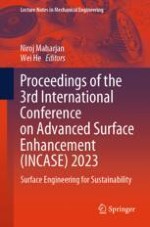This book presents the proceedings of the ‘3rd International Conference on Advanced Surface Enhancement’, INCASE 2023. It compiles the papers presented by researchers in surface engineering field at INCASE 2023 conference. The book presents a comprehensive review of the state of the art in surface engineering-related techniques and strategies, with a focus towards sustainability. The main topics include ‘Advanced techniques for surface engineering towards enhanced performance’, ‘Surface and sub-surface characterisation’, ‘Simulation and modelling of surface integrity’, ‘Advanced coating materials design synthesis and industry applications’, and ‘Emerging trends in surface engineering’. The book identifies the gaps between research and manufacturing and promotes sustainable approaches towards development of surface engineering solutions for adoption by industry. The book is useful for researchers, scientists, students, and engineers working in the field of surface engineering.
